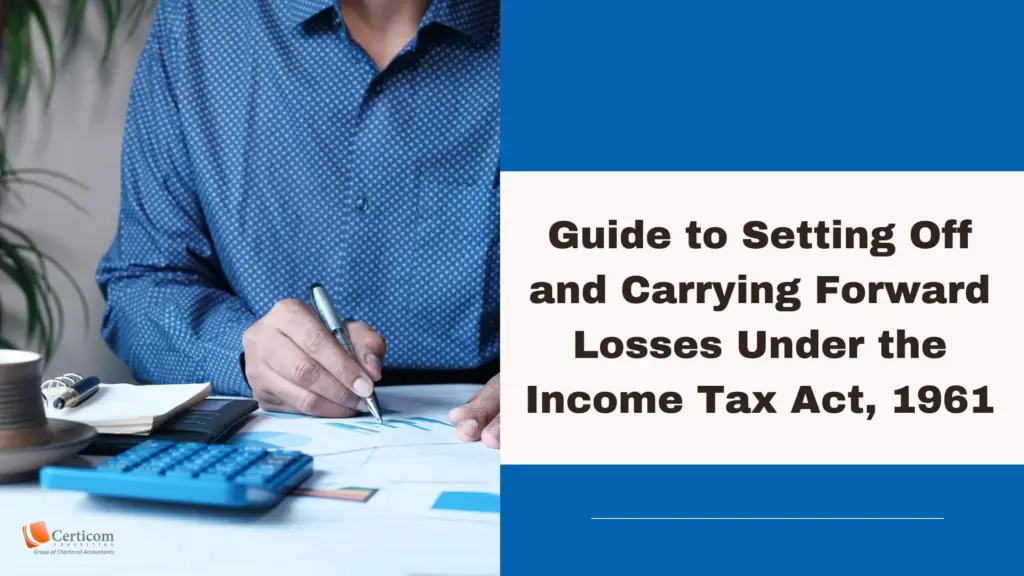Guide to Setting Off and Carrying Forward Losses Under the Income Tax Act, 1961

The Income Tax Act, 1961, provides specific provisions for addressing situations where an individual or entity incurs losses during a financial year. These provisions allow for the set-off and carry-forward of losses, ensuring that taxpayers can efficiently manage their taxable income.
Understanding the Basics of Loss Set-Off
A loss incurred in any assessment year can be set off against income earned in the same financial year. Any remaining loss after this set-off can be carried forward and adjusted against income in subsequent assessment years. Here are the key principles:
Inter-Source Set-Off: Losses from one source of income can be adjusted against income from another source within the same head of income.
Inter-Head Set-Off: Losses under one head of income can be set off against income from another head during the same financial year, subject to specific restrictions.
Carry Forward of Losses: Losses that cannot be fully set off in the current year can be carried forward for adjustment in future assessment years.
Mandatory Set-Off: Taxpayers are required to set off losses in the year they occur. The option to defer or forgo the set-off does not exist.

Filing Requirements for Losses
Only losses reported in a return filed on or before the prescribed due date under Section 139(1) are eligible for carry-forward. Exceptions exist for losses from specified businesses under Section 35AD, which can be carried forward regardless of the filing date.
Types of Losses and Their Treatment
Losses Under the Head “Income from House Property”:
Old Tax Regime: Losses can be carried forward for up to 8 assessment years and set off against income under the same head.
New Tax Regime: Losses under this head are not eligible for set-off or carry-forward.
Losses Under “Profits and Gains of Business or Profession” (PGBP):
Losses can be carried forward for up to 8 assessment years and set off against profits from any business or profession carried on by the taxpayer.
Speculation losses can only be set off against profits from speculative business and can be carried forward for up to 4 years.
Losses from specified businesses under Section 35AD can be carried forward indefinitely but can only be set off against profits from specified businesses.
Losses Under “Capital Gains”:
Short-Term Capital Losses: Can be set off against both short-term and long-term capital gains and carried forward for up to 8 years.
Long-Term Capital Losses: Can only be set off against long-term capital gains and carried forward for up to 8 years.
Losses From Speculative Business:
- Can only be set off against income from speculative business and carried forward for a maximum of 4 years.
Losses From the Activity of Owning and Maintaining Race Horses:
- Can only be set off against income from the same activity and carried forward for up to 4 years.
Order of Set-Off of Losses
The order of set-off is crucial in determining how losses are adjusted. The sequence is as follows:
Current year depreciation.
Current year capital expenditure on scientific research and family planning.
Brought forward losses from business/profession.
Unabsorbed depreciation.
Unabsorbed capital expenditure on scientific research.
Unabsorbed expenditure on family planning.

Special Considerations
Speculative Business:
Includes transactions settled without actual delivery of goods or shares, such as intraday trading.
Speculative losses can only be carried forward and set off against speculative profits.
Loss of Partnership Firms:
Unabsorbed losses due to changes in the firm’s constitution (e.g., partner retirement or death) cannot be carried forward by the firm.
Loss of Closely Held Companies:
Changes in shareholding may restrict the carry-forward of losses unless the change occurs due to specified events, such as shareholder death, insolvency proceedings, or restructuring under approved plans.
Filing Deadlines and Compliance
It is imperative to file returns within the prescribed due date to ensure the eligibility of losses for carry-forward. Non-compliance can render losses permanently ineligible for adjustment in subsequent years.
By adhering to these provisions, taxpayers can strategically manage their income and optimize their tax liabilities while complying with the regulations of the Income Tax Act, 1961.
Related Post
Resident’s Guide to Buying NRI Property in India
Flipkart ESOP Compensation: ₹11 Crore Payout – Salary or Capital Receipt?
Book A One To One Consultation Now For FREE
How can we help? *




